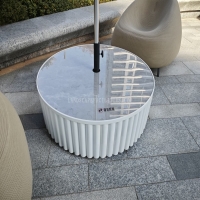Welcome to the website for landscape facilities products and knowledge.
What are the key considerations for designing landscape tables for use in religious or memorial spaces?
Designing landscape tables for religious or memorial spaces requires a thoughtful balance of functionality, symbolism, and aesthetic harmony. These tables often serve as focal points for reflection, prayer, or commemoration, making their design crucial to the overall atmosphere of the space.
1. Symbolism and Meaning: The design should reflect the spiritual or memorial purpose of the space. Incorporate elements like religious motifs, engraved scriptures, or symbolic shapes that resonate with visitors.
2. Material Durability: Choose materials that withstand outdoor conditions while maintaining elegance. Stone, treated wood, or weather-resistant metals are ideal for longevity and a timeless appearance.
3. Harmonious Integration: The table should blend seamlessly with the surrounding landscape. Consider natural colors, organic forms, and placement that enhances the site’s tranquility.
4. Functionality and Accessibility: Ensure the table is usable for rituals, offerings, or quiet contemplation. Accessibility features like appropriate height and seating nearby can improve inclusivity.
5. Cultural Sensitivity: Respect the traditions and beliefs associated with the space. Collaborate with religious leaders or community stakeholders to align the design with cultural expectations.
By prioritizing these factors, landscape tables can become meaningful, enduring additions to sacred or memorial environments.
Related search:

Recommendation
Round metal tube border design table with tempered glass or granite countertop on the top.